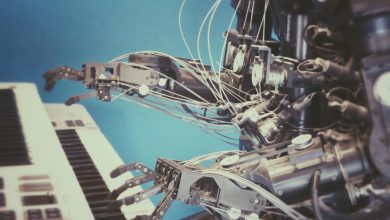
Since the dawn of civilization, human ingenuity has reshaped the world, from the Coliseum in Rome to the Great Wall of China and Machu Picchu in Peru. These monumental achievements formed the building blocks of progress, transforming societies through advanced engineering and strategic vision. Today, a new technological revolution is underway, driven by Artificial Intelligence (AI). Industries such as healthcare, finance, manufacturing, and initiatives like smart cities are eagerly adopting AI, reshaping how we work, communicate, and innovate.
Just as stone and steel formed the foundation of past civilizations, modern fiber-optic infrastructure is the backbone of AI-powered progress. The rise of AI-driven applications, such as autonomous vehicles, real-time analytics, and augmented reality (AR), are pushing network capabilities to the edge. These innovations demand ultra-fast, low-latency connectivity that traditional networks can no longer support. To fully harness AI’s potential, businesses must invest in advanced, resilient infrastructure with fiber-optic networks emerging as the only viable solution.
The AI Bandwidth Boom: Unprecedented Data Demands
The rapid growth of AI-driven applications is driving a significant increase in data consumption. AI models continuously train on massive datasets, processing millions of data points per second. In healthcare, AI-powered diagnostics can analyze complex medical images in real time, helping surgeons detect issues more quickly. Autonomous vehicles, too, rely on AI to interpret sensor data and make critical decisions instantly.
As AI technology advances, the need for high-bandwidth networks becomes even more essential. AI-centric workloads are replacing traditional computing models, requiring real-time data processing with minimal delay. In sectors like healthcare, AI must access and analyze billions of data points globally in an instant to make life-saving decisions. The demand for terabit-level data transfers is no longer theoretical; it is a necessity for deploying AI at scale in industries like gaming, autonomous vehicles, and healthcare.
Low Latency: The Critical Factor in AI Performance
One of the most critical aspects of AI performance is latency. Emerging AI applications, such as autonomous vehicles, rely on real-time decision-making, where a delay of just 100 milliseconds could have life-or-death consequences. As AI continues to evolve, the need to master AI’s controlling sub-AIs will require seamless communication.
Underpinning new, innovative uses of AI are fiber-optic networks that offer the lowest possible latency and ensure applications like autonomous vehicles operate without interruption. Unlike traditional copper or wireless networks, fiber transmits data at near-light speed, cutting latency to mere milliseconds. Fiber is the only infrastructure that can meet these stringent performance demands. In addition, it provides the scalability needed as AI systems grow and evolve, supporting the increasing complexity of AI-driven tasks.
Scaling AI Infrastructure: Fiber as the Backbone
As AI adoption grows, businesses must rethink their networking architectures to support the demand. Fiber serves as the foundational layer for AI infrastructure, offering the scalability and speed needed to handle growing AI workloads. Moving AI operations to cloud-based and data center environments requires high-speed, reliable connections, especially as businesses need continuous access to vast amounts of data. Just as Wall Street paid millions to shave milliseconds off latency for trades, AI applications now demand similar precision for real-time data processing and decision-making.
Fiber is the backbone that enables AI’s explosive growth by providing the high bandwidth and low-latency network required for real-time AI applications. With speeds reaching multi-terabit levels, fiber ensures businesses can scale their AI systems seamlessly while avoiding bottlenecks. As AI applications expand, fiber infrastructure has proven adaptable in supporting the increasing demands of AI-driven analytics and predictive technologies. Fiber is not just an investment for today but a future-ready solution, ensuring the resilience and uptime critical for AI’s ongoing evolution.
Overcoming Legacy Bottlenecks
Many businesses still rely on legacy network infrastructure, such as low-bandwidth VPNs and outdated copper-based connections. While adequate for traditional IT workloads, these solutions are ill-suited for the high-speed data transfer and real-time processing demands of AI-ready networks. As AI adoption grows, businesses can no longer depend on these low-cost connections, which introduce significant latency and limit scalability. Companies must explore faster, more reliable networking solutions to support AI’s evolution.
AI requires real-time access to vast amounts of data, making traditional networking solutions obsolete. Legacy networks, with their high latency and limited bandwidth, slow down AI processing, increasing inefficiency and operational costs. To fully integrate AI into business workflows, companies must transition from old solutions—like 100MB circuits and cable modems—to more robust, higher-capacity connections. Fiber-optic networks are critical for eliminating these bottlenecks, offering the speed and low latency needed for seamless AI performance.
As businesses adopt AI applications, the need for high-bandwidth, low-latency infrastructure becomes clear. Many companies will need to shift from using legacy networks to deploying dedicated 10GB or higher connections to accommodate AI’s data-heavy operations. Additionally, companies must decide whether to store AI workloads entirely in the cloud, on-premise, or a hybrid model that allows both environments to communicate seamlessly. The transition to fiber-based infrastructure will help businesses avoid the limits of outdated networks, allowing for smooth and efficient AI operations.
Security and Reliability: The Next Challenge for AI Networks
Security is a critical challenge as businesses increasingly rely on AI. AI’s ability to detect security vulnerabilities could enable it to penetrate networks before businesses become aware of potential threats. The rogue AI factor is a serious concern—AI systems could learn and adapt to bypass traditional security measures. As businesses move toward cloud solutions, they must consider how sensitive and proprietary information is being shared with AI and how to ensure its security within the AI network.
As AI continues to learn and process more data, safeguarding intellectual property becomes a priority. AI systems learn from the data fed to them, including proprietary business information, leading to unintended consequences. Once AI shares sensitive data, the “secret sauce” could be leaked, potentially harming businesses. Protecting intellectual property requires a new approach to security, ensuring that business-specific data doesn’t inadvertently become public or fall into the wrong hands.
This evolving need for AI security presents a significant challenge, as private AI systems must be developed to maintain control over proprietary information. While private setups are more secure, they are difficult to implement on-premise, and businesses will likely rely on data centers to house and manage private AI systems. These data centers will also need to provide secure interfaces with broader AI networking, establishing robust security parameters for data sharing. This demand for secure infrastructure will require 24/7 reliability, particularly as industries like healthcare rely on AI for mission-critical operations.
To ensure that AI systems are secure and reliable, businesses will need to invest in high-availability data centers with near-perfect uptime, such as “five nines” (99.999%) reliability. Given AI’s critical nature, data centers must guarantee constant availability for businesses relying on real-time processing. However, the increased cost of such infrastructure might deter some businesses. As AI adoption grows, companies must invest in diversified systems to ensure smooth operations and protect sensitive data.
Conclusion: Preparing for the AI-Driven Future
AI is no longer an emerging technology—it is actively reshaping industries and driving digital transformation. As businesses integrate AI into their operations, they must build infrastructure that can handle growing demands for bandwidth, low latency, and security. This infrastructure is foundational not only for the efficient functioning of AI applications, but also for ensuring the longevity and adaptability of businesses that depend on it.
Fiber-optic networks are the backbone of AI-ready infrastructure. With unparalleled scalability, speed, and reliability, fiber-optic systems are essential for supporting the bandwidth-heavy demands of AI and ensuring low-latency communication. As AI-driven processes and data analysis become more integral to business operations, fiber networks provide the necessary reliability to meet AI’s performance expectations and security requirements. By choosing fiber as the core of their network infrastructure, companies position themselves to stay ahead in a fast-paced, data-driven world.
The future of AI requires a network that evolves alongside its technological advancements. Fiber-optic networks have a proven ability to provide the necessary bandwidth to power AI today and enable businesses to future-proof their operations for AI’s inevitable growth. As AI progresses and new applications emerge, fiber networks will support innovations across industries—from healthcare and finance to manufacturing and education. By investing in fiber, organizations can unlock AI’s full potential, driving efficiencies, insights, and breakthroughs that will shape the next era of technological advancement.
Furthermore, businesses must consider how fiber can support future AI innovations, such as quantum computing and next-gen data processing. As AI pushes the boundaries of possibility, fiber’s capacity to evolve will remain critical. To stay resilient and competitive, organizations must build their AI infrastructure on a fiber foundation capable of adapting to AI’s expanding needs. By doing so, they ensure their ability to capitalize on AI’s full potential and drive the future of their industries.




